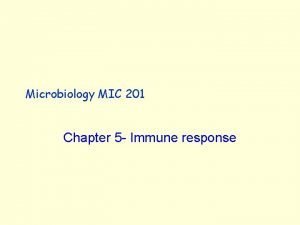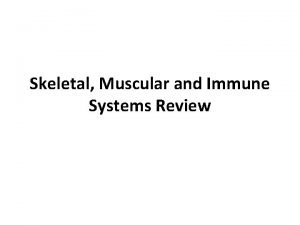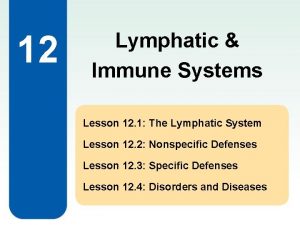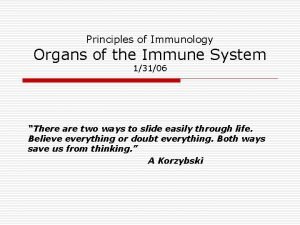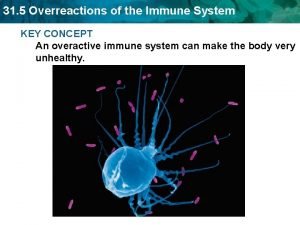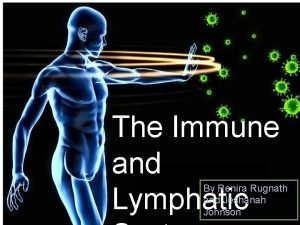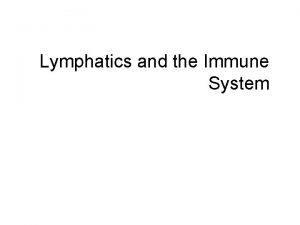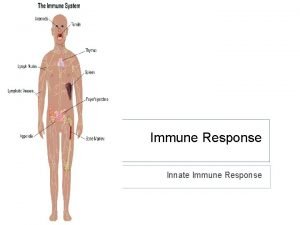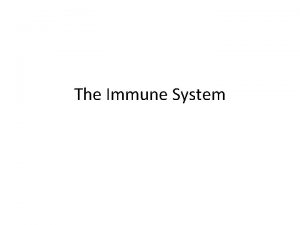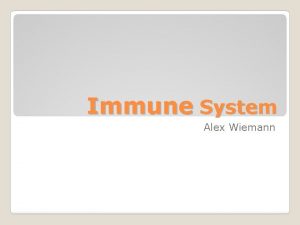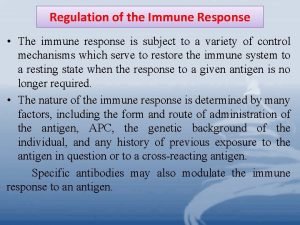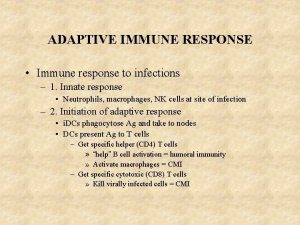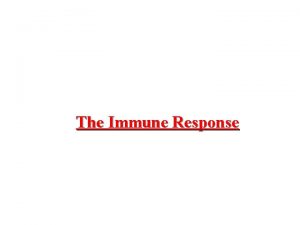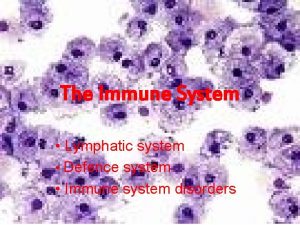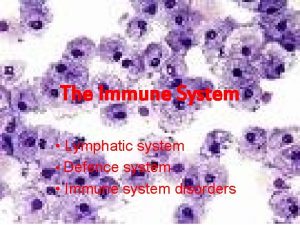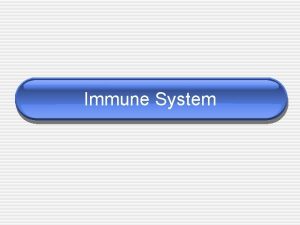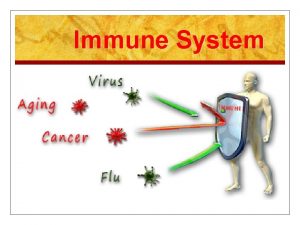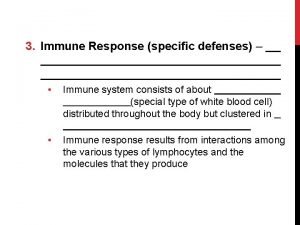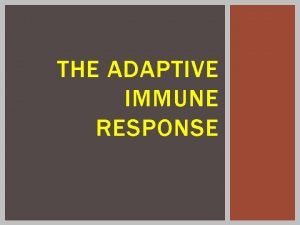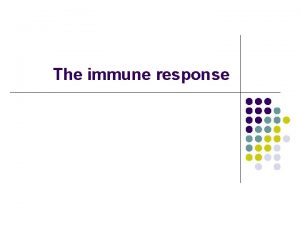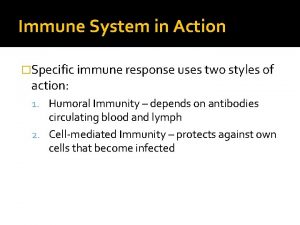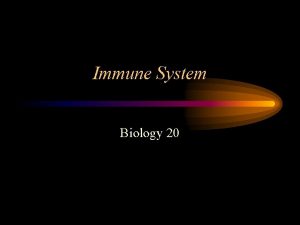Immune System Ch 43 Immune Response in Animals

























- Slides: 25

Immune System Ch. 43

Immune Response in Animals Divided into 2 Categories 1. Innate immunity – present before any exposure to pathogens – effective from the time of birth – involves nonspecific responses to pathogens – consists of external barriers plus internal cellular and chemical defenses

Immune Response in Animals Divided into 2 Categories 2. Acquired immunity (adaptive immunity) – develops after exposure to agents (microbes, toxins, or other foreign substances) – activated after innate immune defense – involves a very specific response to pathogens

Fig. 43 -2 Pathogens (microorganisms and viruses) INNATE IMMUNITY • Recognition of traits shared by broad ranges of pathogens, using a small set of receptors • Rapid response ACQUIRED IMMUNITY • Recognition of traits specific to particular pathogens, using a vast array of receptors • Slower response Barrier defenses: Skin Mucous membranes Secretions Internal defenses: Phagocytic cells Antimicrobial proteins Inflammatory response Natural killer cells Humoral response: Antibodies defend against infection in body fluids. Cell-mediated response: Cytotoxic lymphocytes defend against infection in body cells.

Innate Defense Mechanisms 1. Barrier Defenses (1 st Line of Defense) – Skin – Mucous membranes produce mucus • Traps microbes – Cilia in respiratory system • Sweeps mucus with microbes out of lungs – Body secretions = hostile environment • Lysozymes • Acid in stomach • Oil and sweat give skin acidic p. H

Innate Defense Mechanisms 2. Cellular Innate Defenses (2 nd Line of Defense) • Phagocytic Cells – Neutrophils engulf and destroy microbes – Macrophages are part of the lymphatic system and are found throughout the body – Eosinophils discharge destructive enzymes – Dendritic cells stimulate development of acquired immunity

Neutrophils • Most abundant phagocytic cells in mammals • http: //biologyanimations. blogspot. com/search/label/neutrop hill

Macrophages • http: //www. youtube. com/watch? v=Jg 8 Dob 35 Rp 4

Innate Defense Mechanisms 2. Cellular Innate Defenses (2 nd Line of Defense) • Inflammatory Response – Following an injury, mast cells release histamine, which promotes changes in blood vessels – These changes increase local blood supply and allow more phagocytes and antimicrobial proteins to enter tissues – Pus, a fluid rich in white blood cells, dead microbes, and cell debris, accumulates at the site of inflammation

Inflammatory Response • http: //wps. aw. com/bc_goodenough_boh_3/1 04/26720/6840553. cw/content/index. html

– Inflammation can be either local or systemic (throughout the body) – Fever is a systemic inflammatory response triggered by pyrogens released by macrophages, and toxins from pathogens – Septic shock is a life-threatening condition caused by an overwhelming inflammatory response

Fig. 43 -8 -3 Pathogen Mast cell Splinter Chemical Macrophage signals Capillary Red blood cells Phagocytic cell Fluid Phagocytosis

Innate Defense Mechanisms 2. Cellular Innate Defenses (2 nd Line of Defense) – Complement – proteins that lead to lysis of invading cells – Interferon blocks against cell-to-cell viral infections – Natural killer cells destroy virus-infected body cells and cancerous cells (lyse cell membranes)

Complement • http: //highered. mcgrawhill. com/sites/0072556781/student_view 0/ch apter 31/animation_quiz_1. html

Interferon • Proteins that cause innate defense against viral infections. • http: //highered. mcgrawhill. com/sites/0072556781/student_view 0/ch apter 31/animation_quiz_2. html

Acquired Immunity Mechanisms • White blood cells called lymphocytes recognize and respond to specific antigens • An antigen is any foreign molecule to which a lymphocyte responds – T cells mature in the thymus above the heart – B cells mature in bone marrow • Both travel in the blood, lymphatic system • Each is specialized to recognize a specific type of molecule • A single B cell or T cell has about 100, 000 identical antigen receptors

Acquired Immunity Mechanisms Involves 3 Phases: 1. Recognition – Antigen receptors on B and T cells recognize epitopes (antigens) by binding to them • Antigens = any substance that causes a B or T cell immune response • Epitopes = accessible piece of an antigen

Antigens (Epitopes) • http: //highered. mcgrawhill. com/sites/0072943696/student_view 0/ch apter 14/animation__antigenic_determinants_ _epitopes_. html

Acquired Immunity Mechanisms Involves 3 Phases: 2. Activation Phase – B and T cells are activated by the binding of the antigen receptor – B and T cells undergo rapid cell division – They form • • Effector cells Memory cells

Acquired Immunity Mechanisms Involves 3 Phases: 3. Effector Phase – B cells produce humoral response – produce antibodies – T cells are involved in cell-mediated response • http: //highered. mcgrawhill. com/sites/0072507470/student_view 0/c hapter 22/animation__the_immune_respons e. html

Review of Video • Antigenic Molecules bind to specific B and T Lymphocytes – Lymphocyte becomes active and proliferates – It differentiates into plasma cell and memory cells • Primary Immune Response – Plasma cells fight antigen immediately 7 -10 days • Secondary Immune Response – Memory cells bear the same antigen and circulate for lifetime – Immunological memory

T Helper Cells • http: //highered. mcgrawhill. com/sites/0072507470/student_view 0/ch apter 22/animation__tcell_dependent_antigens__quiz_2_. html

Major Histocompatibility Complex • Cell surface markers that bring the antigen to the cell surface so that T cells are activated • No 2 people have same MHC except identical twins • 2 types – Class I MHC • Found on almost every cell – Class II MHC • Found on specialized cells: macrophages, B cells, activated T cells

Allergies • http: //highered. mcgrawhill. com/sites/0072556781/student_view 0/ch apter 33/animation_quiz_2. html

AIDS • http: //highered. mcgrawhill. com/sites/0072495855/student_view 0/ch apter 24/animation__how_the_hiv_infection_ cycle_works. html
 Primary immune response and secondary immune response
Primary immune response and secondary immune response Primary vs secondary immune response
Primary vs secondary immune response What is the third line of defense in the immune system
What is the third line of defense in the immune system Any substance capable of provoking an immune response
Any substance capable of provoking an immune response Primary immune response
Primary immune response Immune response controller crossword
Immune response controller crossword Primary and secondary immune response
Primary and secondary immune response Cellular immune response
Cellular immune response Cellular immune response
Cellular immune response Muscle type
Muscle type Https://a-z-animals.com
Https://a-z-animals.com Consumer decomposer producer
Consumer decomposer producer Which energy
Which energy Animals that eat both plants and animals
Animals that eat both plants and animals What is the third line of defense in the immune system
What is the third line of defense in the immune system Hangman flowchart
Hangman flowchart Second line of defense immune system
Second line of defense immune system Chapter 35 immune system and disease
Chapter 35 immune system and disease Ap biology immune system
Ap biology immune system Lesson 12.1 lymphatic ducts and vessels
Lesson 12.1 lymphatic ducts and vessels Lesson 12 blood and immune system
Lesson 12 blood and immune system Oobean
Oobean Immune system definition
Immune system definition Overreactions of the immune system
Overreactions of the immune system Lymphatic vs immune system
Lymphatic vs immune system Lymphatic vs immune system
Lymphatic vs immune system








